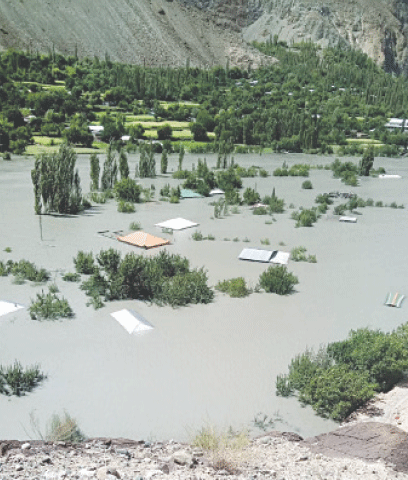• Lake ‘not a threat’ anymore, official says; locals face shortage of essentials as roads in several districts remain blocked
• PM to honour ‘three heroes’ whose timely action saved hundreds of lives; will convene high-level meeting on illegal construction issue this week
GILGIT: Thousands of people in several tehsils of Gilgit-Baltistan remained cut off from the rest of the region after an artificial lake formed by a glacial flood in the Raushan area inundated five to ten kilometres of a major route, which connects Ghizer with other districts and Chitral in Khyber Pakhtunkhwa.
The road to Astore Valley, Shimshal Road in Hunza, Hisper Road, and K-2 Road in Shigar were also blocked, causing a shortage of essentials in these parts. Due to damage to water supply channels, residents in the flood-affected areas, particularly Danyor, Sultanabad, and Jutial in Gilgit, faced a shortage of potable water.
Due to the artificial lake where water levels had started to recede, thousands of residents in Ghizer, up to Shandur Top and Yasin Valley, remained without road access, as the lake also submerged the Hakas suspension bridge.
A resident Waseem Baigal told Dawn that people in disconnected areas were facing multiple issues, including a looming shortage of fuel, food, and other essentials.
Meraj Ali Shah from Yasin Valley said Gilgit-Chitral Road had been submerged in an artificial lake “for ten kilometres”. At least 200,000 people in Gupis, Phander, and Yasin tehsils had been completely cut off for the third consecutive day, he said, adding that due to damage to power infrastructure, people were also facing electricity outages.
He added that the supply of clean drinking water to the areas affected by the floods was still unavailable.
Officials said that besides the 300 houses damaged by the glacial flood, several houses had been submerged due to the lake. However, the authorities said the water in the lake had reduced to 40 feet and it posed no danger to nearby settlements.
“For now, there is no danger,” said GB government spokesperson Faizullah Faraq in a statement. The lake had earlier threatened the downstream areas of Ghizer, Gilgit and Diamer.
In a statement, GB Disaster Management Authority (GBDMA) Director General Zakir Hussain said standard operating procedures (SOPs) had been prepared for releasing water from the artificial lake while keeping the local population and infrastructure safe. The “comprehensive” SOPs were prepared by a technical team that visited the site on August 23 in view of the potential hazards posed by the lake.
According to the administration, work on an alternative route for the temporary restoration of Gilgit-Shandur Road in the area was underway and traffic was expected to resume in the next 48 hours.
The National Highway Authority (NHA) has mobilised heavy machinery for the route’s permanent restoration.
Meanwhile, the residents in flood-hit Daen village, Khalti, Ishkoman, Gupis, and other areas also face a shortage of water, medical facilities, and communication difficulties.
PM to honour ‘heroes’
On the other hand, Prime Minister Shehbaz Sharif has invited three heroes from Gilgit Baltistan (GB) who saved about 300 human lives by providing timely information about the glacial flood in Ghizer district.
“Wasiyat Khan, Ansar and Muhammad Khan have been invited to Islamabad upon the prime minister’s directive”, the PM Office’s media wing said. The PM would present special awards to these three men in recognition of their service.
An official in the PM Office told Dawn that the premier would also convene a meeting with provinces on the issue of illegal constructions along rivers and water channels. The meeting, expected to be be held tomorrow or the day after (Tuesday or Wednesday).
Syed Irfan Raza in Islamabad also contributed to this report
Published in Dawn, August 25th, 2025
